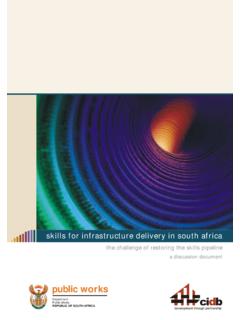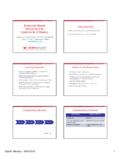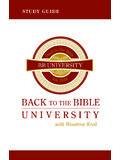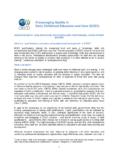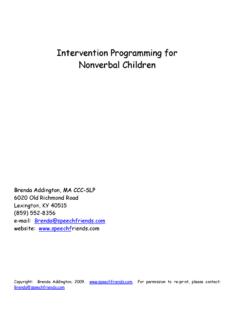Transcription of The Four Purposes of Assessment - Peter Liljedahl
1 Vector 7 The four Purposes of Assessment By Peter Liljedahl Peter Liljedahl an associate professor in the faculty of education at Simon Fraser University. He is a former high school mathematics teacher and currently one of the editors of Vector. INTRODUCTION Over the last several years I have worked with a number of districts across British Columbia in and around issues of classroom Assessment in mathematics. These experiences, along with my experience as the Rethinking Assessment working group leader at the 2009 Canadian Mathematics Education Forum, have afforded me the opportunity to think about the topic of Assessment in mathematics across a large number of discrete, but related, contexts. In doing so I have begun to synthesize and construct an alternative understanding of Assessment that could stand in contrast to the narrowly focused Assessment practices that are so often seen in today's mathematics classroom.
2 In what follows I presented this synthesis as the four Purposes of Assessment . These Purposes are not meant to be comprehensive. Nor are they meant to be prescriptive. But they are meant to be provocative. purpose ONE COMMUNICATION Assessment can be seen as an effective medium for communication between the teacher and the learner. It is a way for the student to communicate their learning to their teacher and for the teacher to communicate back to the student a commentary on their learning. But to what end? To answer this we offer the metaphor of navigation. In order for navigation to take place that is the systematic and deliberate effort to reach a specific place two things need to be known: (1) where you are and (2) where you are going.
3 This metaphor offers us the framework to discuss Assessment as communication students need to know where they are in their learning and where they are supposed to be going with their learning. Each of these will be dealt with in (out of) turn. As teachers, in general, we have very clear goals for ourselves and our teaching. When we structure a unit of instruction, whether it is an activity, a lesson, or an entire curriculum unit, we are trying to achieve something we are trying to induce learning of very specific content. How transparent are we about these goals with our students? What is the value, if any, of being transparent? In a framework of navigation the answers to these questions are obvious. Transparency of our goals would allow students to more clearly see where they are going, and as such, increase the likelihood that they are going to get there.
4 As Stiggins points out, "students can hit any target that they can see" (Stiggins, Arter, Chappuis, & Chappuis, p. 57). So, what exactly are the targets, and how can we help our students to see them? Classically, the targets of a curriculum are what are sometimes referred to as the prescribed learning outcomes (BC Ministry of Education, 2008), but will be referred to here as curriculum goals. These goals are the contents of the curriculum that a teacher is meant to cover within the school year. 8 Summer 2010 However, teachers have goals that go beyond these curricular prescribed learning outcomes. The expanded list of goals may include, but is not limited to, the development of proficiencies in: classroom routines and norms coming to class prepared, putting up your hand, cleaning up, etc.
5 Habits of mind curiosity, flexible thinking, persistence, striving for accuracy, etc. social skills polite listening, turn taking, etc. (Costa & Kallick, 2000). mathematical processes1 communication, connections, mental mathematics and estimation, problem solving, reasoning, technology, and visualization found in the front matter of the BC IRP's as well as in the NCTM Principals and Standards (2000). numeracy / mathematical literacy the ability to solve non-routine contextual problems requiring the use of non-specified (and often low-level) mathematics learning tools comfort and competency with manipulatives, effective group work skills, note taking skills, comfort with ambiguity, etc. sociomathematical norms (Yackel & Cobb, 1996) proof, argumentation, inquiry, etc.
6 This expanded list comprises what can be referred to as a teacher's learning goals2 each of which would be more easily attained if students were made aware of them. 1 In BC these processes are contained in the front matter of curriculum documents (in an introductory chapter). It is unclear as to whether or not they are meant to be considered as curriculum. The same is true for numeracy and mathematical literacy skills. 2 O'Connor (2009) also uses the term learning goals but he uses it in a context synonymous with prescribed learning outcomes. Indeed, it would be almost unheard of for a teacher to work on classroom routines and norms without them first clearly articulating to the students their expectations that is, their goals.
7 However, this same level of clarity is rarely afforded to curriculum goals. In order for students to know where they are meant to go they need to know where the teacher is intending them to go. A clear list of learning goals provided at the beginning of a unit of instruction would give students that clarity of direction. Similarly, Assessment of students' performance against these learning goals will help students to more clearly know where they are in relation to the target. Taken together, learning goal based Assessment becomes a very effective communicative tool to help students navigate their learning. This form of Assessment is not to be confused with outcome based education (OBE) or standards based testing (SBT), both of which also measure students against a priori curricular goals.
8 With their heavy emphasis on empiricism, OBE and SBT practices focus on Assessment as measurement whereas the learning goal based Assessment that is being offered here focuses on Assessment as communication. This is not to say that marks are not gathered, or reported, but rather that the purpose for doing so is to inform the learner about where they are vis- -vis the learning goals. Of note are the critical Assessment issues that are dispensed with when a stance of communication is adopted. For example, the issue of assigning a zero for missed work no longer has any meaning. Neither does the deduction of marks for work submitted late. In both of these instances there is no communicative value in such actions. However, as effective as this stance is at dispensing with issues, it is equally effective in raising them.
9 For example, Assessment instruments are no longer seen as holistic Vector 9 units for which a single mark is recorded. Instead, these are now seen as collections of discrete opportunities for students to demonstrate (communicate) attainment of a variety of learning goals. This changes the way in which students' achievement is tracked. In such a paradigm, performance needs to be recorded in relation to specified learning goals as opposed to the common practice of recording performance in relation to Assessment instruments (O'Connor, 2009). Issues aside, a paradigm shift towards Assessment as communication affords us much greater opportunity for students to partake in, and benefit from, self- and peer- Assessment . In a culture of transparent and understood learning goals, self- Assessment has great meaning.
10 In fact, it could be argued, that self- Assessment in a climate devoid of such transparency has no meaning. Without knowing what the targets are, how could a student effectively evaluate their performance? But this is more than a philosophical shift. It is also a pragmatic shift. In a climate where students have full knowledge of the learning goals and how their work relates to these learning goals self Assessment can become the most effective method for assessing homework, in class assignments, and quizzes. In such a climate, there is no motivation for students to be misleading about their work. In fact, giving students the freedom to record their achievement using codes for correct, incorrect, correct with help, correct but incomplete, did not attempt, etc.

